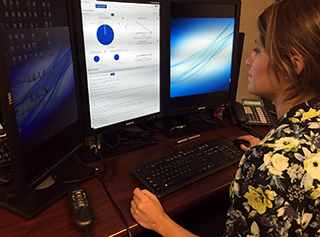Benefits of a web-based radiology resident feedback system
 The training of on-call radiology residents requires timely, relevant feedback by attending radiologists. The Department of Radiology at MedStar Georgetown University Hospital in Washington, D.C., has developed a web-based feedback system for this purpose. This system has made it easier for attending radiologists to efficiently and rapidly comment upon the diagnoses and radiology reports prepared by on-call residents. Attending radiologists are providing more feedback to the residents, user satisfaction by all has improved, and cases where there are substantive discrepancies are being better managed.
The training of on-call radiology residents requires timely, relevant feedback by attending radiologists. The Department of Radiology at MedStar Georgetown University Hospital in Washington, D.C., has developed a web-based feedback system for this purpose. This system has made it easier for attending radiologists to efficiently and rapidly comment upon the diagnoses and radiology reports prepared by on-call residents. Attending radiologists are providing more feedback to the residents, user satisfaction by all has improved, and cases where there are substantive discrepancies are being better managed.
Attending radiologists at teaching hospitals are responsible for communicating diagnostic mistakes made by residents. They need to advise residents of changes made in final reports and the reasons for these. They need to mentor residents who are not preparing optimal report content. And they need to do provide diverse, constructive feedback while dealing themselves with increased workloads, differences in scheduled work hours, and the pressures associated with rapid turnaround time to provide diagnoses and high quality radiology reports to referring physicians.
At MedStar Georgetown University Hospital, attending radiologists review preliminary reports prepared by on-call residents and provide a graded evaluation based on RADPEER scoring for report discrepancy. They also provide free text comments, and positive as well as negative feedback.
With the implementation of a web-based internal system, feedback data are stored in a radiology database that contains report and order data. Feedback can be provided with a few mouse clicks, and is displayed only in the interpreting resident’s electronic folder.
A dashboard has been created for each resident, which contains a pie chart showing the quantity and percentage of reports that an attending radiologist agrees with, reports where subtle changes needed to be made, and reports where there was significant disagreement. Reports with positive feedback and those flagged for follow up are displayed separately. The cumulative performance of a resident’s progress over time is also displayed.
Flagged exams can be accessed online to display exam details as well as the attending radiologist’s comments. Report differences can be compared, and images relating to the report can be accessed with a mouse-click.
Ross W. Filice, MD, chief of imaging informatics, stated that with the implementation of the new system, attending radiologists were more likely to give explicit feedback for subtle and insignificant discrepancies. The convenience of the system motivates attending radiologists to provide more case-specific direction. A before-and-after survey revealed that the number of attending radiologists providing positive feedback also increased substantially. Quality improvement is also documented objectively.
The system is still being optimized. Future projects include creating anonymized teaching files for sharing calls and missed cases in conference, and improvements in the report comparison function by utilizing natural language processing.
Lead author Hailey H. Choi, MD, told Applied Radiology that “the feedback system was well-received by both faculty and resident radiologists. Automated dashboard with retrievable case information allowed near real-time review for the residents and provided more objective evaluation of the resident’s performance, as individual cases could be re-reviewed with the residency program director or section chief. The feedback system has also been adapted for attending-attending peer review at our institution. We believe the feedback system can enhance continued learning and quality improvement in the field of radiology.”
REFERENCE
- Choi HH, Clark J, Jay AK, et al. Minimizing barriers in learning for on-call radiology residents - end-to-end web-based resident feedback system. J Digit Imaging Published online August 24, 2017.
